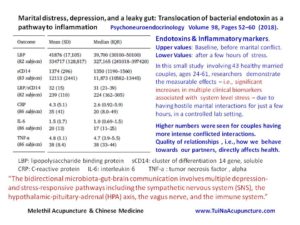Interior Pathogenic Influences (IPIs)
The concept of Internal Disharmony (ID) is a unique contribution of Asian medicines to our ideas of health and wellness. It is likely a part of all traditional systems of medicine that see humans as a whole , i.e., Body + Mind, and as part of the Environment we share with our fellow beings.
ID patterns are linked to our feelings and emotions, and by extension, to our relationships. Sometimes, they are hard to examine.

We will need Compassion on this journey of transformations, both for ourselves, and for how we have treated our relatives. Mitakuye oyas’n.
This Disharmony, an unresolved internal state of chronic tension at the cognitive level, e.g., chronic insecurity related to food (love, mother) or shelter, can lead to objective (measurable) physical manifestations, i.e., clinical signs such as reduced range of movement (ROM), and symptoms such as pain, or feeling depressed, stressed, or anxious. These immobility patterns can also manifest as an “armoring”, a neuromuscular development associated with chronic stress, noted by the psychiatrist Wilhelm Reich (MD).
The primary mechanism, according to TCM, suggests that chronic mental stress/tension leads to individualized patterns of immobility or freeze and often, as a subsequent development or resolution process, migratory patterns of pain that cannot either be provoked or activated by pressure (deep palpation), or by allodynia.
According to the Western clinical framework, this may suggest that there is no “objective” illness or disease. This assessment can upset people’s feelings and exacerbate the signs and symptoms originally manifest by their unique pattern of Internal Disharmony. This is understandable.
We seek diagnostic confirmation, and rapid therapeutic resolution, when we are unwell.
Of special interest is the concept of neural plasticity, the idea that many chronic and resistant mental health issues – e.g., Stress, Anxiety, and Depression syndromes – are also patterns of unresolved inflammation and reduced cognitive plasticity (Resilience) to which we have become bound. These linkages may be due to energetic deficits associated with prior injury, emotional or physical, or prolonged illness, e.g., viral infection, or congenital factors (e.g., Yuan chi deficiency).
How does TCM resolve ID?
We start with the Body and work up to the Mind, sometimes referred to as the Monkey Mind, full of spontaneity and incoherence. For the advanced students, those who wish to see themselves as they truly are, the Spirit comes next.
The first clinical task is to identify, and to resolve, structural imbalances at the physical (Body) level, in the Annamayakosha of Yoga. Without resolving the issues trapped at this foundational level of our Body, directly accessing the Mind and clearing blockages will be challenging.
The Internal Elixir techniques of Taoism (Daoism) suggest that this stage of development (Cultivating Awareness) will take a few months of dedicated study and internal work practices with a qualified teacher, by the student aspirant.
Physical medicine (acupuncture, TuiNa) techniques work well on the Body, with regard to opening the meridians manifest on the skin and reducing musculoskeletal blocks. Regular sessions help us feel our muscles more clearly and prevent the buildup of chronic tension. They will also build bioenergetic interconnections within our internal organs, the foundational basis for acupunctures’ body strengthening and anti-inflammatory benefits, without drugs.
Of special interest is long term Harmony promoted within the Zang organ networks (Liver, Heart, Spleen, Lung, Kidney), by tuning the Sheng (Generating) and Ke (Restraining) relationships using acupuncture.
For example, after regular sessions, an elder who is self medicating with alcohol to overcome loneliness, is experiencing the early stages of cognitive impairment, and has developed atrial fibrillation, will realize that the ritualized daily consumption of alcohol is at the root of their downward health spiral.